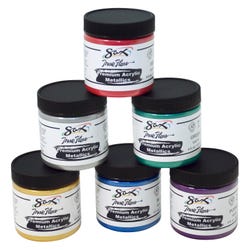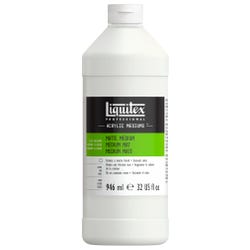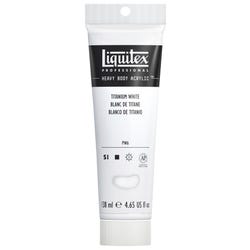Atmospheric Landscapes

Description
Lesson Plan & Art Work by Phyllis M. Annett
The lesson will instruct students on how a combination of a variety of acrylics and mediums can be used as a team to create an Atmospheric Landscape on canvas. Acrylics retain their surface texture when dried. Paint markers can be integrated in the painting for detail. To achieve an atmospheric texture, gloss and matte medium will be used both individually and mixed with paint to create surface variations, depth and transparencies.
Objectives
- Students will gain an understanding of the works of artists who created aerial perspective Atmospheric Landscapes with depth.
- Students will understand the terms, ‘aerial perspective’, ‘linear perspective’, ‘value’, ‘contrast’, ‘glazing’, ‘impasto’, layering’, and ‘transparency’ and how they can all work together to form the illusion of depth and atmosphere in a painting.
- Students will learn how to mix and apply gels and mediums to create the illusion of depth and transparency in their paintings.
- Students will learn how to incorporate non-traditional combinations of product into their paintings.
- Students will learn to use various kinds of brushstrokes and palette knife applications of product.
Supplies Needed
Liquitex® Heavy Body Acrylic Paint, Quinacridone Magenta, 2 oz.
Liquitex® Heavy Body Acrylic Paint, Cadmium Red Medium, 2 oz.
Liquitex® Heavy Body Acrylic Paint, Hookers Green Permanent, 2 oz.
Liquitex® Heavy Body Acrylic Paint, Cobalt Blue, 4.65 oz.
Liquitex® Heavy Body Acrylic Paint, Ultramarine Blue (Green Shade), 2 oz.
Liquitex® Heavy Body Acrylic Paint, Cadmium Yellow Medium, 2 oz.
Liquitex® Heavy Body Acrylic Paint, Dioxazine Purple, 2 oz.
Liquitex® Heavy Body Acrylic Paint, Raw Umber, 2 oz.
Liquitex® Heavy Body Acrylic Paint, Cadmium Yellow Light, 2 oz.
Liquitex® Heavy Body Acrylic Paint, Burnt Umber, 2 oz.
Liquitex® Heavy Body Acrylic Paint, Ivory Black, 2 oz.
Liquitex® Heavy Body Acrylic Paint, Burnt Sienna, 2 oz.
Liquitex® Heavy Body Acrylic Paint, Raw Sienna, 2 oz.
Liquitex® Heavy Body Acrylic Paint, Titanium White, 7 oz.
Liquitex® Re-Think Professional Acrylic Ink Set, Metallic Set of 6
Liquitex® Gloss Gel Acrylic Medium, 32 oz. Jar
Liquitex® Matte Acrylic Medium, 32 oz. Bottle
Liquitex® Flexible Modeling Paste, 32 oz. Jar
Liquitex® Professional Paint Marker Set, Wide Tip, Assorted Colors, Set of 6
Liquitex® Soluvar Spray Varnish, 10.4 oz Can, Gloss
Liquitex® Basic White Synthetic Long Hardwood Handle Value Brush Set, Assorted Size, Set of 6 (Kit includes 6 sets)
Reeves Steel Blade Flexible Painting Knife Set, Assorted Size, Set of 6 (Kit includes 2 sets)
Fredrix Gallerywrap Acid-Free Double-Primed Stretched Canvas, 18" x 24" (Kit includes 6)
*Here are the supplies needed for this lesson plan for reference. Find a convenient carousel of shoppable products for this lesson below.
Standards
Standard #1: Generate and conceptualize artistic ideas and work.
Standard #2: Organize and develop artistic ideas and work.
Standard #3: Define and complete artistic work.
Standard #5: Develop and refine artistic work for presentation.
Standard #10: Synthesize and relate knowledge and personal experiences to make art.
Instructions
1
Winslow Homer, Fredrick Church, Thomas Cole and Sanford Gifford to illustrate atmospheric landscapes. Have students comment on why the paintings appear to have an atmospheric look. Is it the perspective, color, depth, position of form, light, or transparency? Does there seem to be a mist or a vortex of clouds?
2
Explain the difference between linear and aerial perspectives and how we use both to achieve depth in a painting.
Linear Perspective: the use of lines and vanishing points to determine how an object’s size changes with distance.
Aerial Perspective: tells you how an object is affected by the atmosphere between it and the person viewing the work. Leonardo daVinci called this ‘the perspective of disappearance’.
3
Explain how most of the artists mentioned used the basic elements of fire, water and air to make their work a sublime spectacle of epic proportion. Describe and show examples of energetic brushstrokes and combinations of color being used to achieve movement and excitement in paintings.
4
Demonstrate and explain each of the Liquitex® products and experiment with combining them:
• Gloss Gel Medium is heavy bodied and transparent, used to extend acrylics, create texture by the impasto technique, and glaze between layers of paint.
• Matte Medium increases color transparencies, is ideal to achieve a specific atmosphere in a painting, and can be mixed with Gloss medium to create a satin finish.
• Liquitex® Professional Acrylic Inks are a permanent, fluid, acrylic emulsion that dries quickly, are water-resistant once dry, and give a wonderful watercolor effect.
• Liquitex® Professional Paint Markers are lightfast, permanent, acrylic markers, which have been formulated to work with all other Liquitex® products.
• Liquitex® Flexible Modeling Paste can be mixed with Gel Medium to build textures and reliefs.
5
Have students take a small sheet of canvas to practice techniques like impasto using mediums with and without paint using brushes, palette knives, or any inventive tools.
6
Inform and explain the five methods Turner, Church, Homer, Cole and Gifford used to achieve depth and atmosphere in their art work: Diminishing Size; Diminishing Detail; Diminishing Contrast; and Lightening of overall values; and Neutralization of color with a possible shift to blue.
7
Have students begin their paintings with a base coat of light colors on their canvas to block out areas of the sky, land and possibly water, to make up a guide for their composition of foreground, middle ground and background.
8
Students will coat their base coat with a layer of gloss, matte, or a combination of the two mediums to blur the edges of areas. Let this transparent layer dry fully.
9
As paintings progress, the students will create layers of paint (including Liquitex® Professional Ink and utilizing Liquitex® Professional Markers) with or without medium and also layers of clear medium to create transparencies. The layers will also increase the depth of the paintings by blurring the edges of areas
10
Students will use a variety of painting techniques, such as energetic brush strokes, impasto, line, overlapping of transparent colors, fine brushstrokes and blending of one color into another.
Note: It is important to dry the painting between layers of paint and mediums.
11
Lastly, have students critique the work of others and their own to see if they have achieved the illusion of an atmospheric landscape in all of the paintings.











